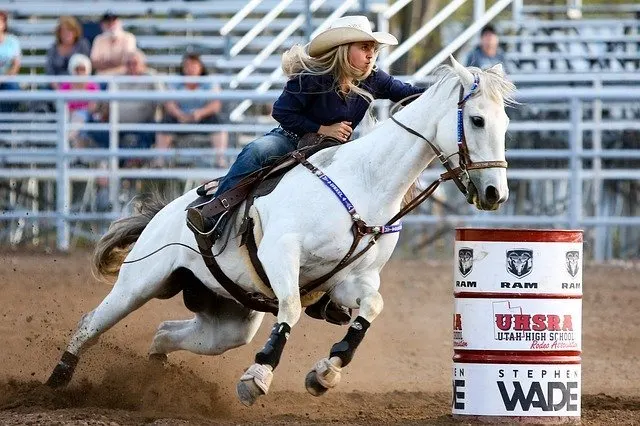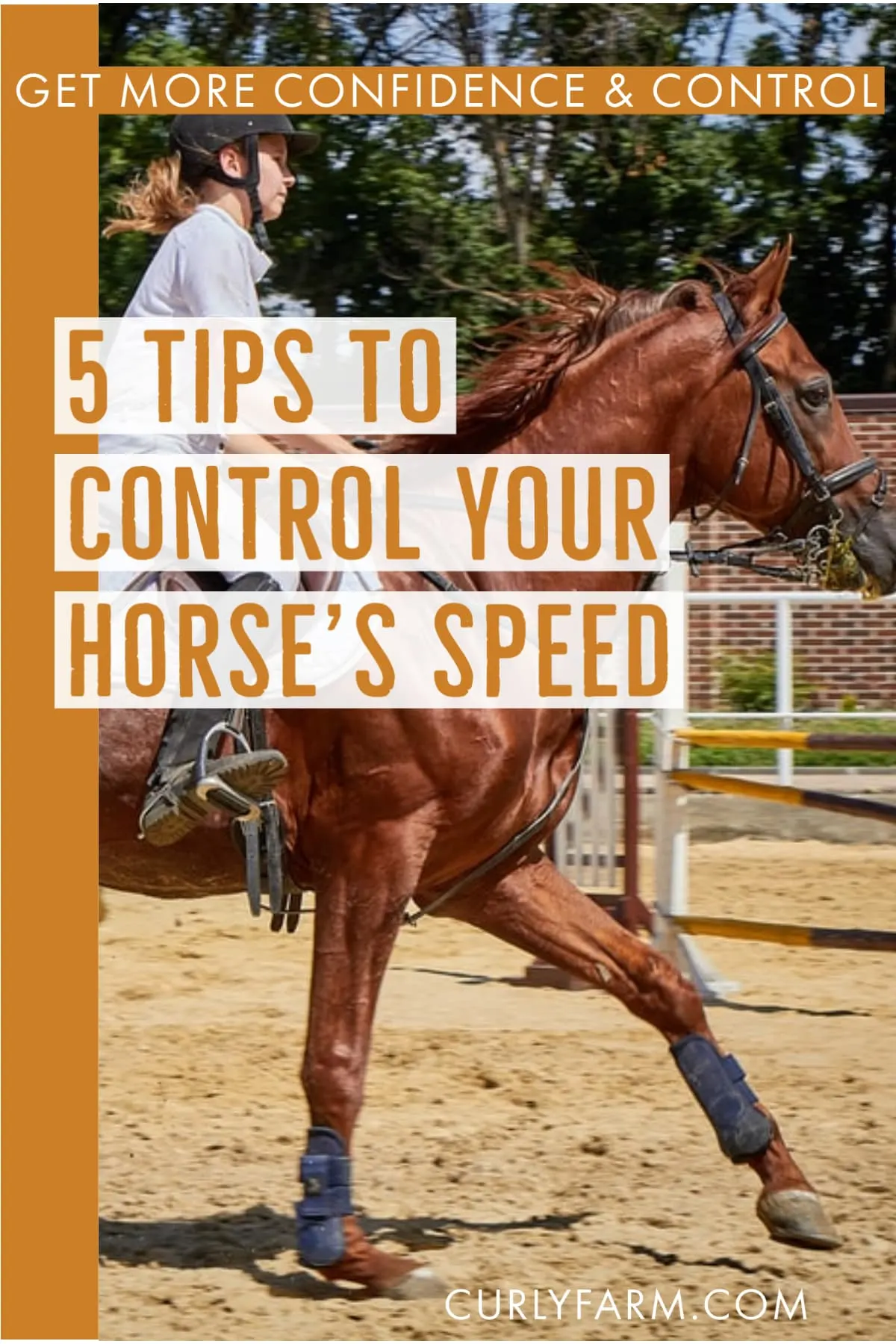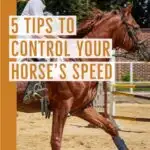Most horses have four main gaits: the walk, the trot, the canter (called a lope in Western riding), and the gallop. Within these gaits, horses have a huge variance- horses can be taught to trot or even lope as slow as other horses walk!
The speed of each gait depends on many factors. Just like how fast you walk might vary according to:
- energy level,
- desire to get to your destination,
- your body’s natural pace,
- the length of your legs,
- and what feels good to your body at the time.
By altering these factors for your horse- plus understanding biomechanics of horse gait transitions and adding a little bit of basic training- we can adjust your horse’s speed. By slowing down or speeding up a horse’s gait, you can create paces that are comfortable for you to ride. In this article, we’ll talk about a few ways to speed up or slow down your horse’s walk, trot, or canter so that you can be a more comfortable and confident rider.

1. Use your body to set your horse’s pace
Horses are giant animals that do have their own rhythm at every gait, but don’t underestimate how powerful your body weight can be, especially when you move it in a particular pace and rhythm. Imagine giving a small child a piggyback ride, but that child pulling sharply back on your shoulders each time you try to take a step forward- it would certainly change your pace, wouldn’t it? You can do the same thing by using your body well when you are in the saddle.
Post to the Trot
While posting is traditionally an English riding method, many Western horse trainers use it to help train a horse to trot at a certain pace. Posting involves arising out of the saddle by just a few inches each time the horse’s outside leg reaches forward. Practice posting with your horse’s rhythm, and then try altering your horse’s pace by posting at a slightly altered rhythm- by rising and sitting just a bit slower, your horse will likely accommodate in order to carry you more easily.
🌟 Pro tip: posting shouldn’t rely entirely on placing weight in the stirrups. To develop good posting muscles, try doing it bareback on a well-trusted horse!
2. Use Your Reins to Slow a Too Fast Horse
Note: If you ride your horse in a curb bit, (including a Tom Thumb bit) or another harsh bit, do not correct their speed using your reins. (Read more about why by clicking here)
For horses ridden in a gentle bit with contact between the rider’s hands and the bit, you can use what is called a “half-halt” to slow your horse down. A half-halt is similar to what it sounds like – your hands tighten slightly on the reins giving the horse a very light cue to stop while your body continues to ride forward. Done correctly, this balances a too fast horse and cues them to slow down slightly.

3. If Needed, Exercise Your Horse Before Riding
Some horses just have a lot of energy, and that energy gets converted into a hard-to-control fast pace at the walk, trot, or canter.
If you need to, it’s okay to do the groundwork with your horse before riding. This may involve putting your horse in a round pen to get out some extra energy. If you don’t have a round pen, a properly used lunge line works just fine to work the horse in a circle around you. Remember to practice safe lunge line use and never wrap the line around your hands.
Read more about lunging a horse before riding and some pitfalls to avoid.
4. Sit Deeper to Slow a Gait
One of the same tricks that works to halt your horse with your body often also works to slow a fast horse down.
Sometimes horses speed up because they feel the tension in our body (which we may have because they are going too fast in the first place!) and reacts with anxiety of their own- which they express through tension and speed. Learn more about how to calm down an anxious horse here.
To help your horse slow down a trot, canter, or even a walk, try this:
- take a deep breath out
- as you exhale, sink your seatbones deep in the saddle,
- drop your heels below your toes in the stirrups.
These body movements signal to the horse that you are relaxed. The resting movement makes it harder for them to continue to propel themselves forward at a faster-than-comfortable walk, trot, or canter
5. Focus on Gentle, Balanced Transitions
Often, horses get started at an uncomfortable pace in a gait because they are off balanced during the transition.
When off-balance, a horse may scramble forward to catch their momentum. Clean, balanced transitions from walk-to-trot or trot-to-canter can start the gait at a balanced and comfortable pace.
Many new riders will squeeze, kick, or even smack a horse on the rump to get them into an upward gait transition. While this may accomplish the gait change, the horse is, effectually, chased into the faster gait- usually at a rate of speed that is uncomfortable for the rider.
For more balanced transitions: Don’t kick or use a whip. Instead, start by putting your shoulders back and heels down (this balances yourself on top of your horse and helps them remain balanced), squeeze your horse, and give the cue for the next gait. If your horse explodes from a walk to a trot, start over immediately. Halt them, and then began at a walk and request the trot again. When the horse takes a transition that is smooth balanced and even-paced, praise them and continue at that gait.
Using the Trot for Conditioning Workouts
The trot is one of the best gaits for working out – both for horse and rider! The gait requires sustained physical exertion on the part of both the horse and the rider, but not too much, making it a great endurance training tool. Try taking your next trail ride on a familiar trail at an easy trot. This gait is a great way to make boring trail rides a little more exciting once you’ve trained your horse to maintain a comfortable even-paced trot. It also b builds muscle and endurance in both horse and rider.
For extra exercise, post to the trot instead of sitting the trot. Posting means rising out of the saddle slightly in timing with the horse’s gait. Posting to the trot takes a little more work on the part of the rider, but saves a bit more effort for the horse – perfect for if you need to trot long distances and don’t want to wear out your horse. Traditionally, posting to the trot is only done in English riding, but no rule says you can’t do it in a Western saddle! Many professional Western trainers will post to the trot to help their horse learn pacing by using their own body to set a rhythm.



Jesse F
Tuesday 4th of August 2020
I like how you mentioned that the gallop, trot, canter, and walk are the main gaits that horses like to travel. My brother is thinking of taking me on a guided horseback riding trip because my birthday is coming up and I've never ridden on a horse before. I'll have to pass this information along to my brother so he can know how to control the horse's speed while riding them.